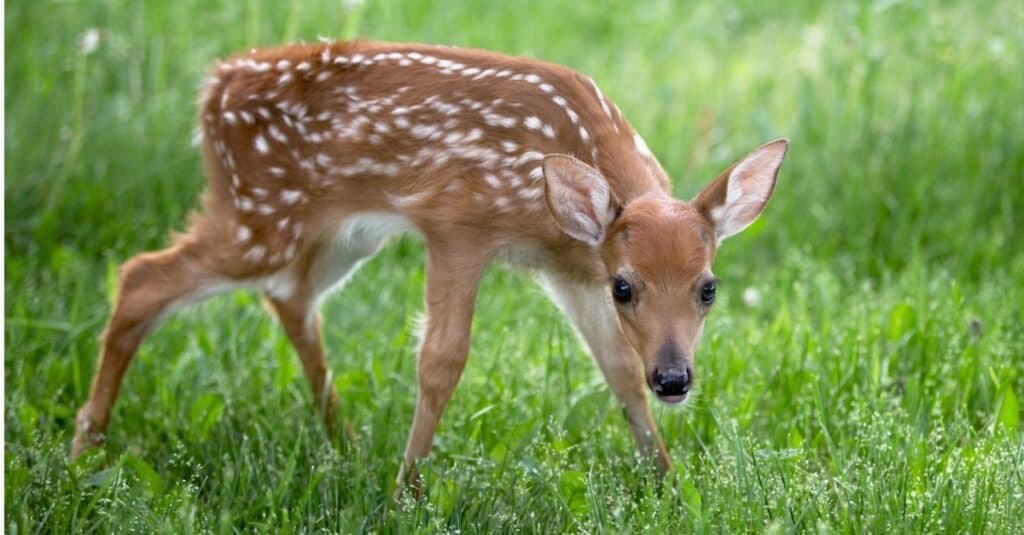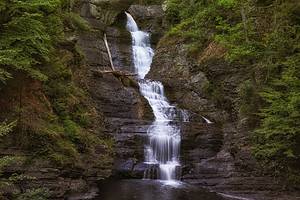Niagara Falls are home to three massive waterfalls in the Niagara Falls State Park. Each year, 8 million people flock to see the majestic waterfall bordering New York and Canada. There is no surprise as to why.
In the tourist-heavy section, you can look up and see gigantic and breathtaking waterfalls. The waters rush quickly and fall with grace. Even during the cold winter months when most bodies of water freeze, you can still watch the Niagara drip down the waterfall. Knowing how gorgeous this place is, can you imagine if the water just stopped? This happened in 1969!
Keep on reading to discover why Niagara Falls once ran dry and why it’ll go dry again.
Why Did Niagara Falls Run Dry?

The U.S. Army Corps. of Engineers dried the American Falls to study erosion.
©CPQ/Shutterstock.com
So, what happened? What caused the foam and mist-producing North American wonder to dry? While most people would assume it was natural or caused by the weather, this is untrue. Niagara Falls ran dry on purpose because of a study!
According to the official Niagara Falls USA website, the U.S. Army Corps. of Engineers turned off the American and Bridal Veil Falls to study the effects of erosion. We are still seeing the effects of erosion today.
But, how did they do it? Well, it was not easy. The team first used 27,800 tons of rock and earth to construct a 600-foot cofferdam. This dam acted as a stopping point and prevented the flow of water from reaching the American Falls. In no time after the installation of the dam, researchers could see the ‘face’ or the bottom of the dam. Using sandblasters, they sandblasted loose pebbles and stones and added a sprinkle to water the shale layer.
The researchers did not leave the project empty-handed. Instead, the team studied the effects of erosion over 6 months. The purpose was to find a solution to the massive erosion problem, which was causing dangerous rock slides. The information they obtained was used to create a walkway directly on the riverbed for additional tourists.
After six months of research, the team completed their work, and the falls were ‘turned on’. In less than two hours after opening a section of the river to the falls, the water was rushing back down, creating the iconic American Falls mist.
Will it Go Dry Again?
The problem of erosion is not gone. Niagara Falls continues to suffer from erosion, causing weaknesses in the earth and rock slides. Some reports indicate New York will turn off the spectacular waterfall in the next two to three years. Nothing is certain, though, or has been announced.
Why? Two 115-year-old bridges desperately need an upgrade. With time, structures wear down. The two bridges have seen better days and were built between 1900 to 1901. The bridge runs across the Niagara River above the American Falls and is for cars and pedestrians. Currently, the bridges are closed and in their place are temporary truss bridges, but they block parts of the view millions of tourists fly and drive to see.
Sadly, there are a lot of unknowns. The state of New York and other officials are working together to decide on the new bridge design and materials. At the same time, engineers are looking for innovative ways to dewater the American Falls without affecting the wildlife and the rest of the falls in the same area.
The History of Niagara Falls

A French explorer, Father Louis Hennepin, ‘discovered’ the majestic falls in December 1678.
©YingHui Liu/Shutterstock.com
At the end of the ice age, likely 12,000 years ago, Niagara Falls was formed. For over 200 years tourists have been coming to the state park to watch the stunning falls, but long before tourists came to the area, Native Americans lived near the rushing waters.
Scientists believe when the glaciers were melting during the end of the ice age, the water drained the Niagara River. With nowhere to go, the water then over the edge of the Niagara Escarpment.
In the next hundred years, the rushing water eroded rocks and natural resources to create the rushing falls we know today. Father Louis Hennepin, a French explorer, ‘discovered’ the majestic falls in December 1678. The explorer took the opportunity to claim the land as part of France and built forts at the mouth of the falls, which are still there!
Erosion will continue to wear at Niagara Falls over time. It’s believed that in about 50,000 years or so the falls will erode their way to Lake Erie. Like all geological features, the end of Niagara Falls will come, but not in the lifetime of anyone you’ll know!
The Biodiversity of Niagara Falls

White-tail deer
are common near Niagara Falls.
©iStock.com/Lynn_Bystrom
With how fast and hard the water rushes in Niagara Falls, it’s probably hard to imagine animals living in the waters, but they do! Actually, in the 400+ acres of land, you can find at least 300 species of birds like green herons, warblers, swallows, and sparrows.
When the state park is open, you can take the hiking trails for a beautiful walk. During the walk, red-tailed hawks, red foxes, and white-tail deers are common. As exciting as it is to see a black bear or mountain lion, these large predators are shy and rare. Black bears stay to themselves and cougars have not been officially recorded in the Niagara area since the 1800s.
What about inside the falls? There is a diverse fish population in both the lower and upper Niagara Rivers. Don’t worry about the fish diving into the lower river from the top of the falls! They are strong swimmers and even when they go over the falls; they most often survive! But, hungry birds wait for them at the bottom.
If you like fishing, there are plenty of areas in the Niagara River where the state allows it. Fish like walleye, salmon, smallmouth bass, largemouth bass, yellow perch, and steelhead are common throughout the rivers.
Interesting Facts About Niagara Falls
Want to keep learning about these stunning falls? Keep on reading our interesting facts!
- In just one second, 3,160 tons of water flow over Niagara Falls.
- Before the construction of the first suspension bridge, there were no black squirrels in Niagara Falls. They are native to Canada. Now, you can see hundreds, if not thousands, of black squirrels in the region.
- No country owns the full Niagara Falls, but there is a clear boundary drawn on maps.
- Lake Huron, St. Clair, Superior, Michigan, and Erie supply water to Niagara Falls.
- During the construction of the Robert Moses Power Plant in Lewiston, 20 construction workers died.
Thank you for reading! Have some feedback for us? Contact the AZ Animals editorial team.








